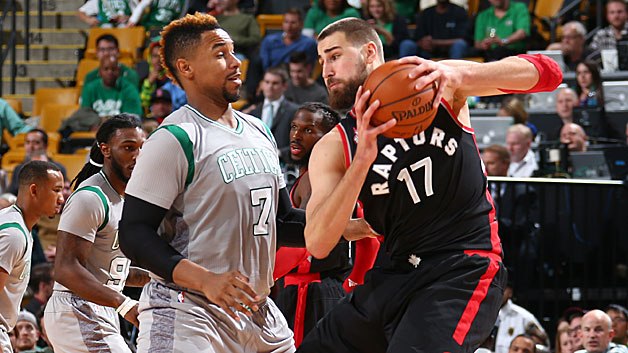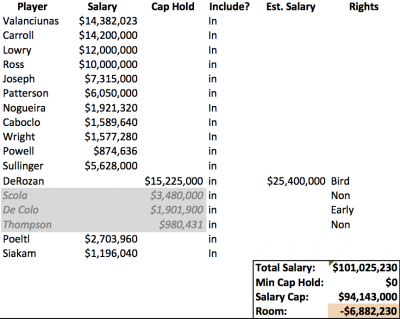The Toronto Raptors have reportedly signed Jared to a one-year, $5.63-million contract using the team’s mid-level exception. You can read everything you need to know about that addition here, and what follows is simply an update of the team’s roster and salary cap sheet.
Roster
The roster now stands at 14 players. The team seems pretty covered at the guard spots and at center, which creates the impression that the final roster spot, barring a trade, will be used on a small forward or combo-forward.
Here’s what the rotation looks like right now, in rough terms:
PG: Kyle Lowry, Cory Joseph, Delon Wright
SG: DeMar DeRozan, Terrence Ross, Norman Powell
SF: DeMarre Carroll, Bruno Caboclo
PF: Patrick Patterson, Jared Sullinger, Pascal Siakam
C: Jonas Valanciunas, Lucas Nogueira, Jakob Poeltl
Some of that looks a little off because the five traditional positions don’t really hold anymore. The Raptors play a ton of two-point guard ball, players can fill in for multiple positions, and their guard depth more than helps cover up for what appears to be a hole at the three. The positions players can play actually line up more like this:
PG: Lowry, Joseph, Wright, Powell (in a pinch)
SG: DeRozan, Ross, Powell, Joseph, Wright (maybe)
SF: Carroll, DeRozan, Ross, Powell (smaller threes), Caboclo
PF: Patterson, Sullinger, Carroll, Siakam, Poeltl (the team thinks so long-term, though I disagree at present)
C: Valanciunas, Nogueira, Poeltl, Sullinger
When you look at the options the Raptors have that way and consider how good the Raptors looked going small last year, there’s not a clear “hole” to fill. I’d still guess they’d like another multi-position forward defender, and the guess here is that they would prefer a veteran (sorry, Melvin Ejim) given they employ six inexperienced players already. But the roster is such that they could go in a few different directions with the final roster spot.
And again, trades can still happen, so this could all change.
Cap Sheet
By using the mid-level exception on Sullinger, the Raptors preclude themselves from carving out cap space. They probably only could have gotten to $5.1 million in cap space without trading someone, and doing so would have required renouncing a lot of rights and losing a few exceptions. This was always the most likely path, as we explained in far more detail in our salary cap primer.
After the Sullinger signing, here’s what the Raptors’ cap sheet looks like (there’s some disagreement on the actual amount of DeMar DeRozan’s cap hold, but it no longer matters).
Because the team has committed to staying over the cap, they’re free to officially re-sign DeRozan to his new deal. Expect that to happen early next week before DeRozan takes off to USA Olympic camp, and/or when the team returns from Summer League. DeRozan’s deal has been reported to be anywhere from $137.5M to $145M, and so his first-year salary could be anywhere from $23.92M to $26.54M. We also don’t know whether that gap in reported salary is misreporting or, more likely, due to incentives – Daniel Hackett and I discussed it and are assuming “likely” incentives, which count against the cap, push the number to $139M and “unlikely” incentives, which count only for luxury tax right now, push it to $145M.
Luckily, the difference in cap hit no longer matters much to Toronto (it will for luxury tax purposes). Whether he’s at $23.92M or $26.54M or anywhere in between, the Raptors are out of cap space.
That means the Raptors have the following means of adding players:
Bi-annual exception: The Raptors can sign a player with a starting salary of $2.2M on a deal up to two years, with a 4.5-percent raise in year two ($4.5M total). If they use this exception, it will be unavailable next season.
Minimum exception: The Raptors can sign any number of players at the minimum salary for their years of services. Players with three or more years of service will count as the two-year minimum for luxury tax purposes.
Thompson & Scola: The Raptors can re-sign either Thompson or Scola using their Non-Bird Rights, which allow the team to exceed the cap to pay them up to 20 percent of their previous salary (or 20 percent above the minimum), on a deal up to four years in length, with annual raises of up to 4.5 percent of the first-year salary. Basically, if Scola or Thompson want to return cheap-ish, they can.
Trades: The Raptors can acquire players in trades still. Now that they’re above the cap, they can’t just absorb salary, but they can add more salary in a trade. Here’s a look at how much they can take back, courtesy CBAFAQ.com.
| Outgoing salary | Maximum incoming salary |
|---|---|
| $0 to $9.8 million | 150% of the outgoing salary, plus $100,000 |
| $9.8 million to $19.6 million | The outgoing salary plus $5 million |
| $19.6 million and up | 125% of the outgoing salary, plus $100,000 |
This is for non-tax-paying teams only, but the Raptors remain far enough away from the tax ($113.3M) to worry much about it. Even if they re-signed Scola to a full 20 percent raise, kept DeRozan on the books, and maxed out his first year salary, they’d still be more than $1M below the tax.
As a best estimate, the Raptors could add about $6.55M in a trade without going into the tax. They can exceed the tax in a trade, too, but they can’t go above the $117.3M “hard cap” (“tax apron”) they triggered by using the MLE.
TOO LONG TOO COMPLEX WHAT DO I NEED TO KNOW
*The Raptors used the MLE, not cap space, to sign Sullinger.
*They have the $2.2M bi-annual exception and the minimum exception to sign a 15th man.
*They can re-sign DeRozan whenever now.
*They can still add salary through trade and go into the tax, but their salary can’t exceed $117.3M and they have to follow salary-matching rules to make deals.




